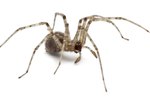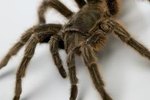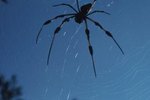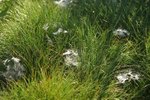
If you get the heebie-jeebies thinking about spiders, you’ll be sorry to hear that over 40,000 species of arachnids live in the world. Don’t feel too bad, because only a few are harmful to humans, according to the University of Florida Entomology Department. Spiders reproduce by laying their eggs in a sac. Female spiders can carry the egg sac wherever they go or deposit it in a web.
Courtship
A male spider displays several behaviors during courtship, hoping the female will accept his sperm. These behaviors include pulling on the web, rocking his body, pushing the female’s legs, vibrating his abdomen, tapping on the web, making rolling motions with his palps (which protrude from his mouth and are sometimes mistaken for legs) and tapping the female spider.
Reproduction
A male spider deposits his sperm into a sperm web, holding it in his palps. Then he cautiously approaches a female spider. The male spider deposits the sperm into an opening on the underside of the female spider’s abdomen. The female fertilizes her eggs with the stored sperm and then lays them into an egg sac. She can hold the sperm of several different males in her spermatheca, which is the internal sperm storage area. Female spiders will sometimes eat the smaller males during mating.
Egg Sac
Spiders make their egg sacs with silken threads shaped like a ball. The spider disperses the threads through spinnerets near the bottom of the abdomen. The threads are in a liquid form when secreted and become solid when released into the air. Spiders use these threads not only to form egg sacs but also to build webs and nests, and for travel. The egg sacs can contain hundreds of eggs. After about two to three weeks, the eggs hatch into live spiders. It takes about one year for the hatchlings to reach adulthood.
Spiderlings
Tiny hatchling spiders, known as spiderlings, immediately begin traveling away from the egg sac. Spiderlings climb to the top of a branch or grass, then produce silken threads. Wind catches the threads and carries the hatchling spiders over long distances, where they colonize habitats far from their birthplace. This dispersion of hatchling is known as ballooning. Whether walking or ballooning, many of these baby spiders become prey to birds, other spiders, wasps and insecticides.
References
Resources
Photo Credits
-
Photos.com/Photos.com/Getty Images
Writer Bio
Karen Curley has more than 18 years experience in health and nutrition, specializing in healthy food choices for families. She received USDA certification in food components, nutrient sources, food groups and infant/child nutrition, and holds a B.A. in English from the University of Massachusetts. Curley is also an avid gardener, home renovator, Collie breeder, dog groomer and dog trainer.




